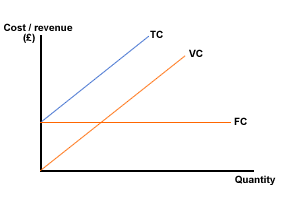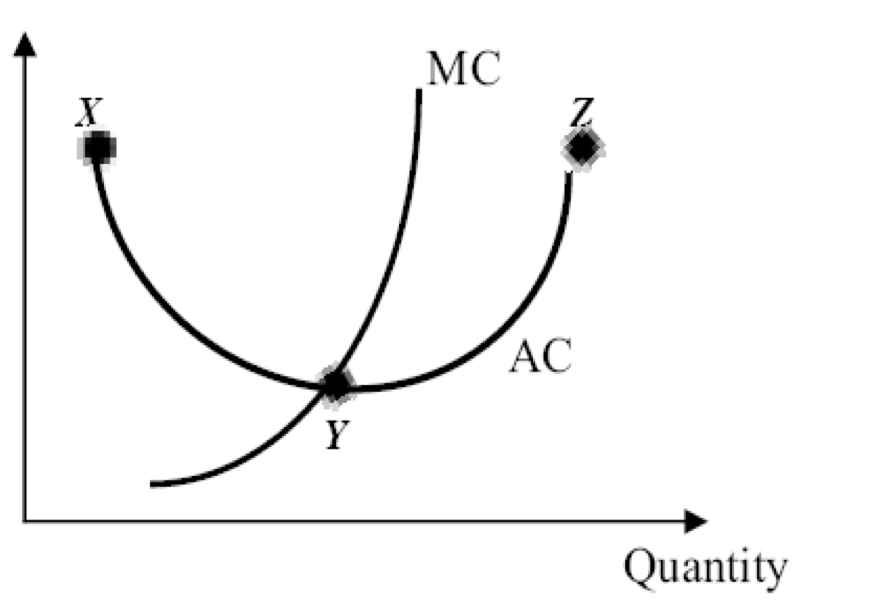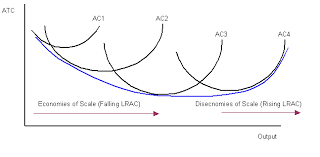2.3 The Firm (Costs of Production)
1/59
Earn XP
Name | Mastery | Learn | Test | Matching | Spaced |
|---|
No study sessions yet.
60 Terms
Total revenue
Selling price multiplied by quantity sold
Profit
Occurs when selling price is greater than costs of production
Subnormal profit
Profit that is earned below normal profit; Average cost is greater than average revenue
Normal profit
The minimum amount of profit which the entrepreneur needs to earn in the short run to keep resources in their present use in the long run; Average cost is equal to average revenue
Supernormal/Abnormal/Economic profit
The profit earned in excess of normal profit; Average revenue is greater than average cost
The Short Run
A period of time during which at least one factor of production is fixed in supply
The Long Run
A period of time in which all of the factors of production can be varied in quantity
The Law of Diminishing Marginal Returns
If increasing quantities of a variable factor of production are added to a given quantity of a fixed factor of production, eventually a point will be reached where the addition to the total output begins to decline
Does the Law of Diminishing Marginal Returns apply in the short run or in the long run?
Only in the short run, as it is only in the short run that at least one input is fixed
What are the assumptions that underlie the Law of Diminishing Marginal Returns?
Technology remains constant, Constant quality, One fixed factor
Why must technology be constant for the LDMR to apply?
If a technological breakthrough occurs, and there are advancements in technology then the law begins again from the start
Why must quality be constant for the LDMR to apply?
The variable factors added to the fixed factor must be of the same quality so they have the exact same skill and education as the previous workers
Why must one factor be fixed for the LDMR to apply?
It only applies in the short run, so one factor will be fixed
Fixed Costs
Costs that do not change as output changes
Variable Costs
Costs that vary as output changes
Examples of Fixed Costs
Rent, Mortgage, Managerial Salary
Examples of Variable Costs
Raw materials, Wages, Utility Bills
A business will survive in the short run if they cover what kind of cost?
Variable Costs
Why can a business survive if they cover their variable costs?
Fixed costs may not have to be paid for a period of time, whereas variable costs are an immediate liability. A business will survive in the short run if their revenue can cover their variable costs as they can negotiate an extension on payment of their fixed costs, and any extra profit can go towards repayment.
Total Costs
Both fixed and variable costs added together; How expensive it is to produce a product when all factors are considered
Average Fixed Cost
Fixed costs divided by the number of units produced
Average Cost
The total of average fixed and average variable costs
Marginal Cost
The additional cost to produce one extra unit of a good
Explicit Costs
The monetary costs a firm pays for inputs. They require a cash outlay by the firm.
Example of Explicit Costs
Rent, Wages
Example of Implicit Costs
The owner’s time and investment into the firm
Implicit Cost
Non-monetary costs that are often hard to quantify
Sunk Costs
Costs incurred by a firm that cannot be recovered if the firm ceases trading
Profit Maximisation
MR = MC
Marginal Revenue
The extra revenue generated from selling an extra unit of output
Average Revenue
The revenue per unit sold
Show the relationship between TC, FC and VC on a graph
TC = FC + VC

Show the relationship between MC and AC on a graph

Why does the SRAC curve slope downwards?
Fixed costs spread over larger output: AC is high when quantity produces is small as the fixed costs are spread over a small output, as units produced increases the unit cost falls
Specialisation: Existing workers become more efficient resulting in lower unit costs due to less mistakes
Why does the AC curve slope upwards?
Law of Diminishing Marginal Returns: After the optimum point AC tends to rise as the LDMR begins to
What is the relationship between MC and AC?
When MC is less than AC then AC is falling
When MC is greater than AC then AC is rising
When MC is equal to AC it is the lowest/optimum point
What is the relationship between SRAC and LRAC
Firms always operate in the short run, so the long run is a series of short run average cost curves
As the firm expands it will have different factory sizes and hence different SRAC curves
It will always wish to produce at the lowest point on the SRAC curve
We end up with a hollow U-shaped LRAC curve like above

Economies of Scale
The forces at work which result in a reduction in the LRAC of production as the firm increases its size of operation
Internal Economies of Scale
Forces at work within a firm that cause the average costs of that firm to decline as the firm expands
Labour Economies
A job can be separated into components, workers can become more skilled, efficient and thus specialised, increasing output per worker
Purchasing Economies
Large firms may be able to avail of discounts when purchasing raw materials, lower supply costs when buying in bulk
Financial Economies
Larger firms may have access to a greater range of finance options and may be able to borrow at lower rates of interest
Managerial Economies
Large firms can attract the best managers which can motivate and then inspire staff, they can reduce inefficiencies and thus the average cost of production
Technical Economies
Larger firms can afford the most advanced technology which increases efficiency and reduces production costs
External Economies of Scale
Forces outside a firm that cause the average costs of all firms to decline as the industry expands
Better infrastructure
As roads and communications improve then all firms will benefit from shorter delivery times, better communication and less fuel usage
Support from Public Bodies
Some public bodies help particular industries by providing grants and subsidies which reduces the unit cost of production
Development of separate R & D units
As the industry becomes very large, R&D agencies may set up to provide facilities for individual firms
Diseconomies of Scale
Forces at work which result in an increase in the LRAC of production as the firm expands
Internal Diseconomies of scale
Forces within a firm that cause the average costs of that firm to increase as the firm expands
Managerial Diseconomies
The bigger the firm, the harder it is to manage. The directors may not know all the necessary information which can result in communication problems
Interest of workers
Workers may feel like a cog in the wheel of production, they may lose motivation and mistakes increase which makes them less efficient and increases cost per unit
Unproductive staff
The firm must hire solicitors, accountants and other employees who do not directly contribute to producing goods and thus increase the average cost of producing a product
External Diseconomies of Scale
Forces at work outside a firm that cause the average cost of all firms to increase as the industry expands
Increased Demand for Labour
Skilled labour becomes very short in supply causing wages to rise, and firms may be forced to employ less skilled workers, costs will increase
Greater need for infrastructure
Greater demands are made on the economy’s infrastructure, the current state may be inadequate. Traffic congestion leads to increased delivery time which increases the cost of distributing the product
How can the government improve the competitiveness of small firms?
Reduce the minimum wage: Employers could get cheaper labour and reduce costs, they could negotiate to lower PAYE and limit pay rises.
Reduce utility charges: Reducing costs for electricity, gas, postage and waste charges would reduce the costs of production.
Develop infrastructure: Improvement of roads and broadband would make it easier for small businesses to operate effectively.
Why do small firms survive in the Irish Economy?
Small size of market: The restricted size may not facilitate the operation of large-scale business, like in a rural area.
Personal services: Consumers may desire personal attention and a small firm will be the only type to provide this.
Consumer loyalty: A small firm may have built up a reputation over the years in the provision of goods and services and consumers may be loyal.
Economic advantages of falling production costs for the Irish economy:
Increased Competitiveness: With lower costs, prices may fall for Irish goods and exports may become cheaper.
Lower Prices: Inflation may fall and this could entice consumers to purchase more goods.
Increased employment: With rising demand, businesses may increase demand for labour.
What objectives might a firm have other than profit maximisation?
To become a takeover target: some firms build a business that may not generate profit, and have specific assets valuable to other firms, causing them to be bought out to eliminate competition.
To satisfy a sufficient level of profit: Increasing output involves financial risks that entrepreneurs aren’t willing to put in, so they will just build a business to a normal level of profit.
To alleviate a social/environmental problem: Social enterprises build businesses to provide a solution to a particular problem rather than pursue profits.